The Impact of the Financial Crisis on the Health Care
VerifiedAdded on 2021/02/03
|15
|4189
|26
AI Summary
Contribute Materials
Your contribution can guide someone’s learning journey. Share your
documents today.
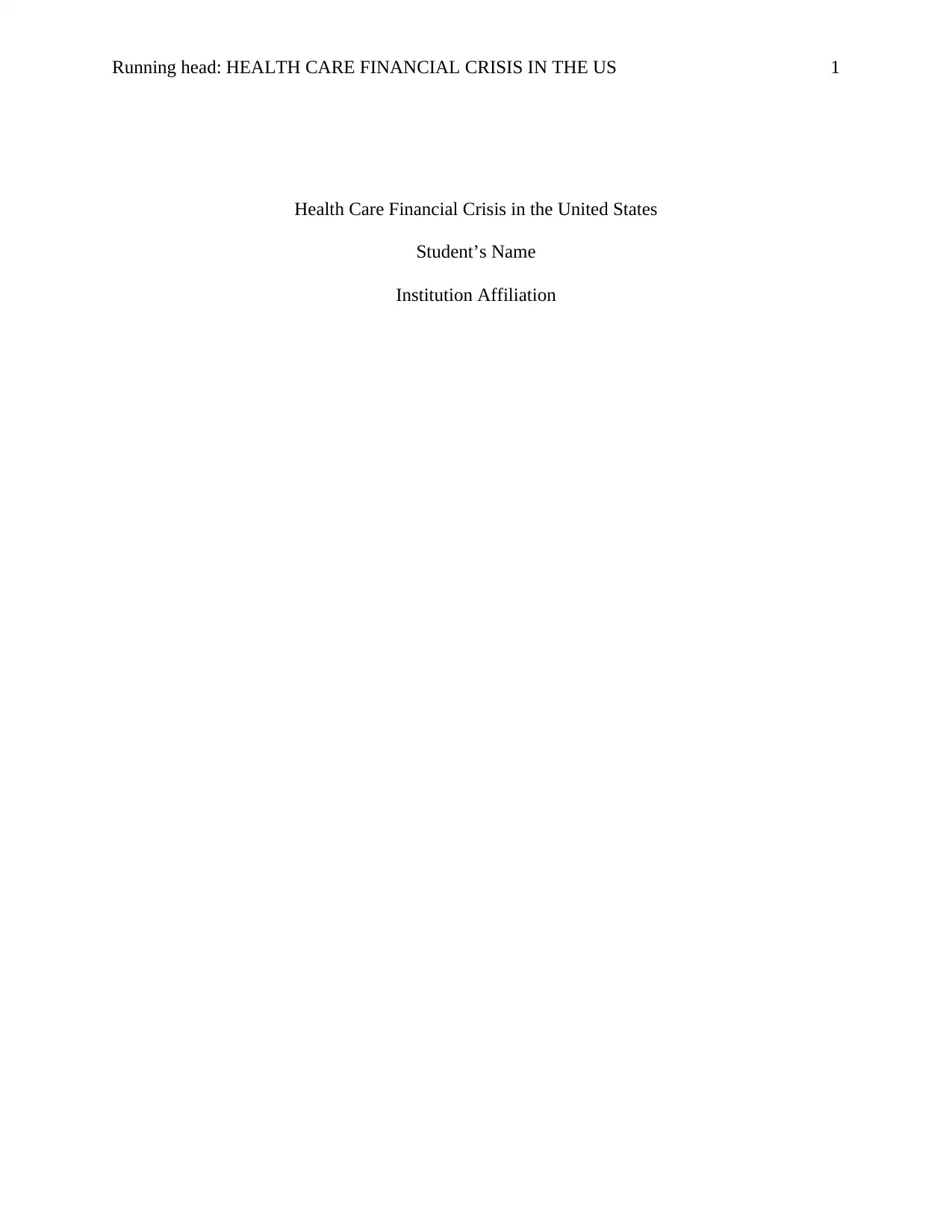
Running head: HEALTH CARE FINANCIAL CRISIS IN THE US 1
Health Care Financial Crisis in the United States
Student’s Name
Institution Affiliation
Health Care Financial Crisis in the United States
Student’s Name
Institution Affiliation
Secure Best Marks with AI Grader
Need help grading? Try our AI Grader for instant feedback on your assignments.
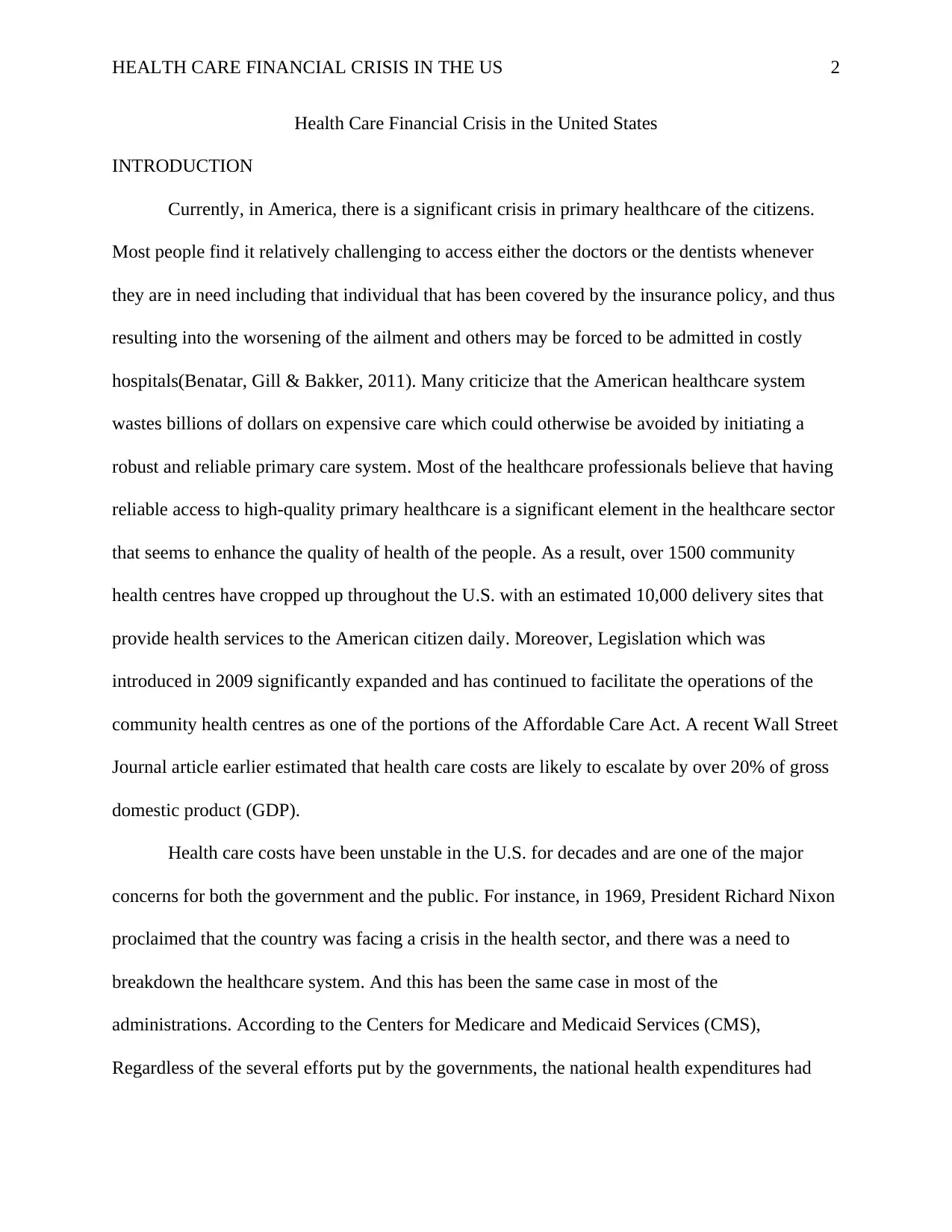
HEALTH CARE FINANCIAL CRISIS IN THE US 2
Health Care Financial Crisis in the United States
INTRODUCTION
Currently, in America, there is a significant crisis in primary healthcare of the citizens.
Most people find it relatively challenging to access either the doctors or the dentists whenever
they are in need including that individual that has been covered by the insurance policy, and thus
resulting into the worsening of the ailment and others may be forced to be admitted in costly
hospitals(Benatar, Gill & Bakker, 2011). Many criticize that the American healthcare system
wastes billions of dollars on expensive care which could otherwise be avoided by initiating a
robust and reliable primary care system. Most of the healthcare professionals believe that having
reliable access to high-quality primary healthcare is a significant element in the healthcare sector
that seems to enhance the quality of health of the people. As a result, over 1500 community
health centres have cropped up throughout the U.S. with an estimated 10,000 delivery sites that
provide health services to the American citizen daily. Moreover, Legislation which was
introduced in 2009 significantly expanded and has continued to facilitate the operations of the
community health centres as one of the portions of the Affordable Care Act. A recent Wall Street
Journal article earlier estimated that health care costs are likely to escalate by over 20% of gross
domestic product (GDP).
Health care costs have been unstable in the U.S. for decades and are one of the major
concerns for both the government and the public. For instance, in 1969, President Richard Nixon
proclaimed that the country was facing a crisis in the health sector, and there was a need to
breakdown the healthcare system. And this has been the same case in most of the
administrations. According to the Centers for Medicare and Medicaid Services (CMS),
Regardless of the several efforts put by the governments, the national health expenditures had
Health Care Financial Crisis in the United States
INTRODUCTION
Currently, in America, there is a significant crisis in primary healthcare of the citizens.
Most people find it relatively challenging to access either the doctors or the dentists whenever
they are in need including that individual that has been covered by the insurance policy, and thus
resulting into the worsening of the ailment and others may be forced to be admitted in costly
hospitals(Benatar, Gill & Bakker, 2011). Many criticize that the American healthcare system
wastes billions of dollars on expensive care which could otherwise be avoided by initiating a
robust and reliable primary care system. Most of the healthcare professionals believe that having
reliable access to high-quality primary healthcare is a significant element in the healthcare sector
that seems to enhance the quality of health of the people. As a result, over 1500 community
health centres have cropped up throughout the U.S. with an estimated 10,000 delivery sites that
provide health services to the American citizen daily. Moreover, Legislation which was
introduced in 2009 significantly expanded and has continued to facilitate the operations of the
community health centres as one of the portions of the Affordable Care Act. A recent Wall Street
Journal article earlier estimated that health care costs are likely to escalate by over 20% of gross
domestic product (GDP).
Health care costs have been unstable in the U.S. for decades and are one of the major
concerns for both the government and the public. For instance, in 1969, President Richard Nixon
proclaimed that the country was facing a crisis in the health sector, and there was a need to
breakdown the healthcare system. And this has been the same case in most of the
administrations. According to the Centers for Medicare and Medicaid Services (CMS),
Regardless of the several efforts put by the governments, the national health expenditures had
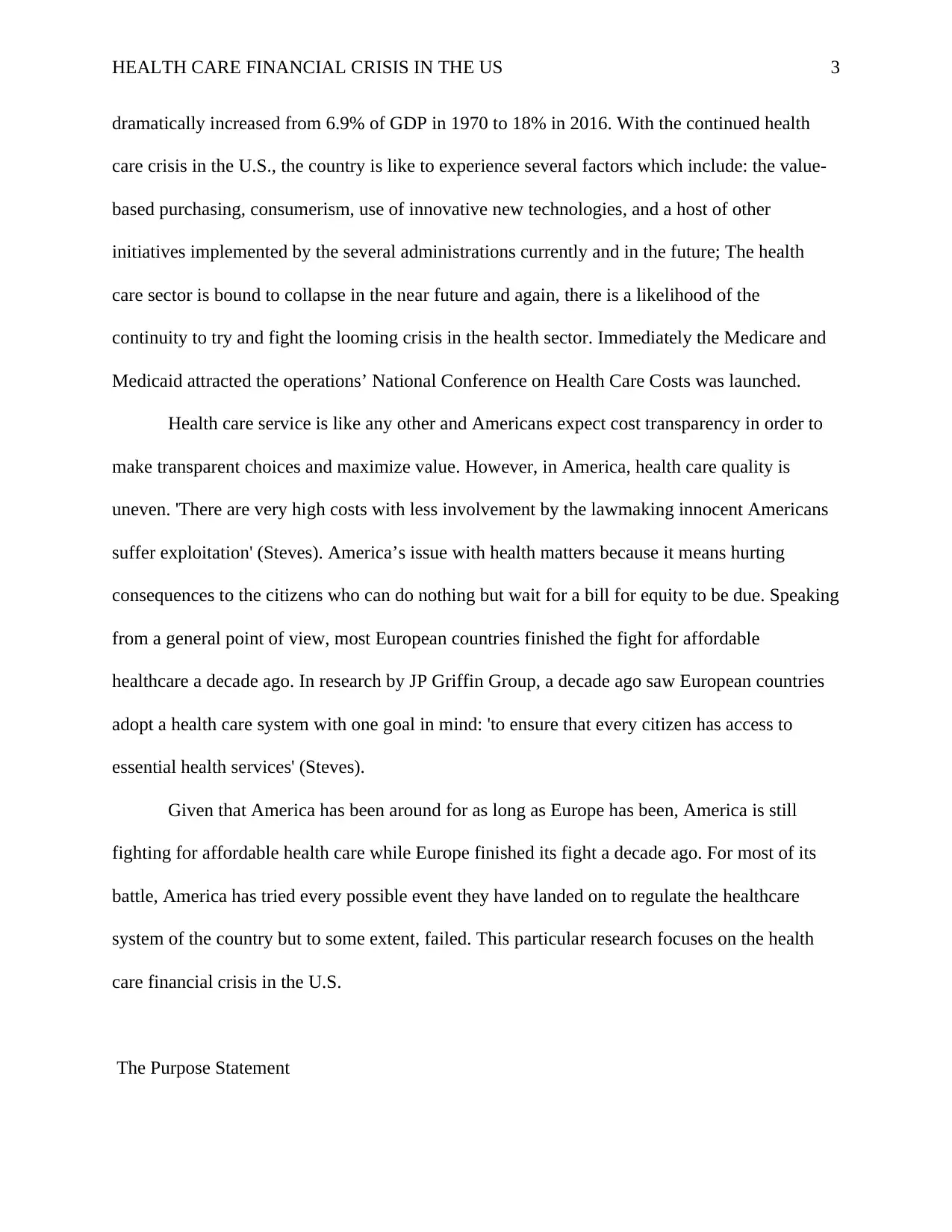
HEALTH CARE FINANCIAL CRISIS IN THE US 3
dramatically increased from 6.9% of GDP in 1970 to 18% in 2016. With the continued health
care crisis in the U.S., the country is like to experience several factors which include: the value-
based purchasing, consumerism, use of innovative new technologies, and a host of other
initiatives implemented by the several administrations currently and in the future; The health
care sector is bound to collapse in the near future and again, there is a likelihood of the
continuity to try and fight the looming crisis in the health sector. Immediately the Medicare and
Medicaid attracted the operations’ National Conference on Health Care Costs was launched.
Health care service is like any other and Americans expect cost transparency in order to
make transparent choices and maximize value. However, in America, health care quality is
uneven. 'There are very high costs with less involvement by the lawmaking innocent Americans
suffer exploitation' (Steves). America’s issue with health matters because it means hurting
consequences to the citizens who can do nothing but wait for a bill for equity to be due. Speaking
from a general point of view, most European countries finished the fight for affordable
healthcare a decade ago. In research by JP Griffin Group, a decade ago saw European countries
adopt a health care system with one goal in mind: 'to ensure that every citizen has access to
essential health services' (Steves).
Given that America has been around for as long as Europe has been, America is still
fighting for affordable health care while Europe finished its fight a decade ago. For most of its
battle, America has tried every possible event they have landed on to regulate the healthcare
system of the country but to some extent, failed. This particular research focuses on the health
care financial crisis in the U.S.
The Purpose Statement
dramatically increased from 6.9% of GDP in 1970 to 18% in 2016. With the continued health
care crisis in the U.S., the country is like to experience several factors which include: the value-
based purchasing, consumerism, use of innovative new technologies, and a host of other
initiatives implemented by the several administrations currently and in the future; The health
care sector is bound to collapse in the near future and again, there is a likelihood of the
continuity to try and fight the looming crisis in the health sector. Immediately the Medicare and
Medicaid attracted the operations’ National Conference on Health Care Costs was launched.
Health care service is like any other and Americans expect cost transparency in order to
make transparent choices and maximize value. However, in America, health care quality is
uneven. 'There are very high costs with less involvement by the lawmaking innocent Americans
suffer exploitation' (Steves). America’s issue with health matters because it means hurting
consequences to the citizens who can do nothing but wait for a bill for equity to be due. Speaking
from a general point of view, most European countries finished the fight for affordable
healthcare a decade ago. In research by JP Griffin Group, a decade ago saw European countries
adopt a health care system with one goal in mind: 'to ensure that every citizen has access to
essential health services' (Steves).
Given that America has been around for as long as Europe has been, America is still
fighting for affordable health care while Europe finished its fight a decade ago. For most of its
battle, America has tried every possible event they have landed on to regulate the healthcare
system of the country but to some extent, failed. This particular research focuses on the health
care financial crisis in the U.S.
The Purpose Statement

HEALTH CARE FINANCIAL CRISIS IN THE US 4
The purpose of this specific paper aims at highlighting issues regarding health care in America.
The research paper empathizes on highlighting the current health care crisis in the U.S. and
beyond its borders right and illustrate more on the problem of health care.
RESEARCH QUESTIONS
The survey questions emphasize on the healthcare crisis in America. The questions are connected
to the health care issue and how the health care system to address the ever looming financial
crisis in the sector and control of the various health care strategies. The research questions assess
the link that exists between the health practitioners and the patients.
1. What are some of the health care strategies in the U.S.?
2. What are the plans for enhancing health care in America?
3. How has the U.S. government policies impacted on the health care system?
LITERATURE REVIEW
Why Affordable Healthcare is an Issue in the U.S.
According to a recent study by The Commonwealth Fund, the U.S. comes last in a survey
of 11 countries' healthcare systems (Schneider et.al 2014). In this study, the performance of the
overall industry is measured from five factors such as; administrative efficiency, care process,
equity, outcomes, and access and in four out of five elements, the U.S. takes position 11.
Affordable healthcare is an issue in the U.S. because even the Legislation cannot get an e grip of
the system, and this has seen the scheme grow to become more expensive and less accessible to
common citizens. The issue of affordable healthcare becomes much of a big problem because
one of the richest countries in the whole world has high-quality doctors with excellent hospital
The purpose of this specific paper aims at highlighting issues regarding health care in America.
The research paper empathizes on highlighting the current health care crisis in the U.S. and
beyond its borders right and illustrate more on the problem of health care.
RESEARCH QUESTIONS
The survey questions emphasize on the healthcare crisis in America. The questions are connected
to the health care issue and how the health care system to address the ever looming financial
crisis in the sector and control of the various health care strategies. The research questions assess
the link that exists between the health practitioners and the patients.
1. What are some of the health care strategies in the U.S.?
2. What are the plans for enhancing health care in America?
3. How has the U.S. government policies impacted on the health care system?
LITERATURE REVIEW
Why Affordable Healthcare is an Issue in the U.S.
According to a recent study by The Commonwealth Fund, the U.S. comes last in a survey
of 11 countries' healthcare systems (Schneider et.al 2014). In this study, the performance of the
overall industry is measured from five factors such as; administrative efficiency, care process,
equity, outcomes, and access and in four out of five elements, the U.S. takes position 11.
Affordable healthcare is an issue in the U.S. because even the Legislation cannot get an e grip of
the system, and this has seen the scheme grow to become more expensive and less accessible to
common citizens. The issue of affordable healthcare becomes much of a big problem because
one of the richest countries in the whole world has high-quality doctors with excellent hospital
Secure Best Marks with AI Grader
Need help grading? Try our AI Grader for instant feedback on your assignments.
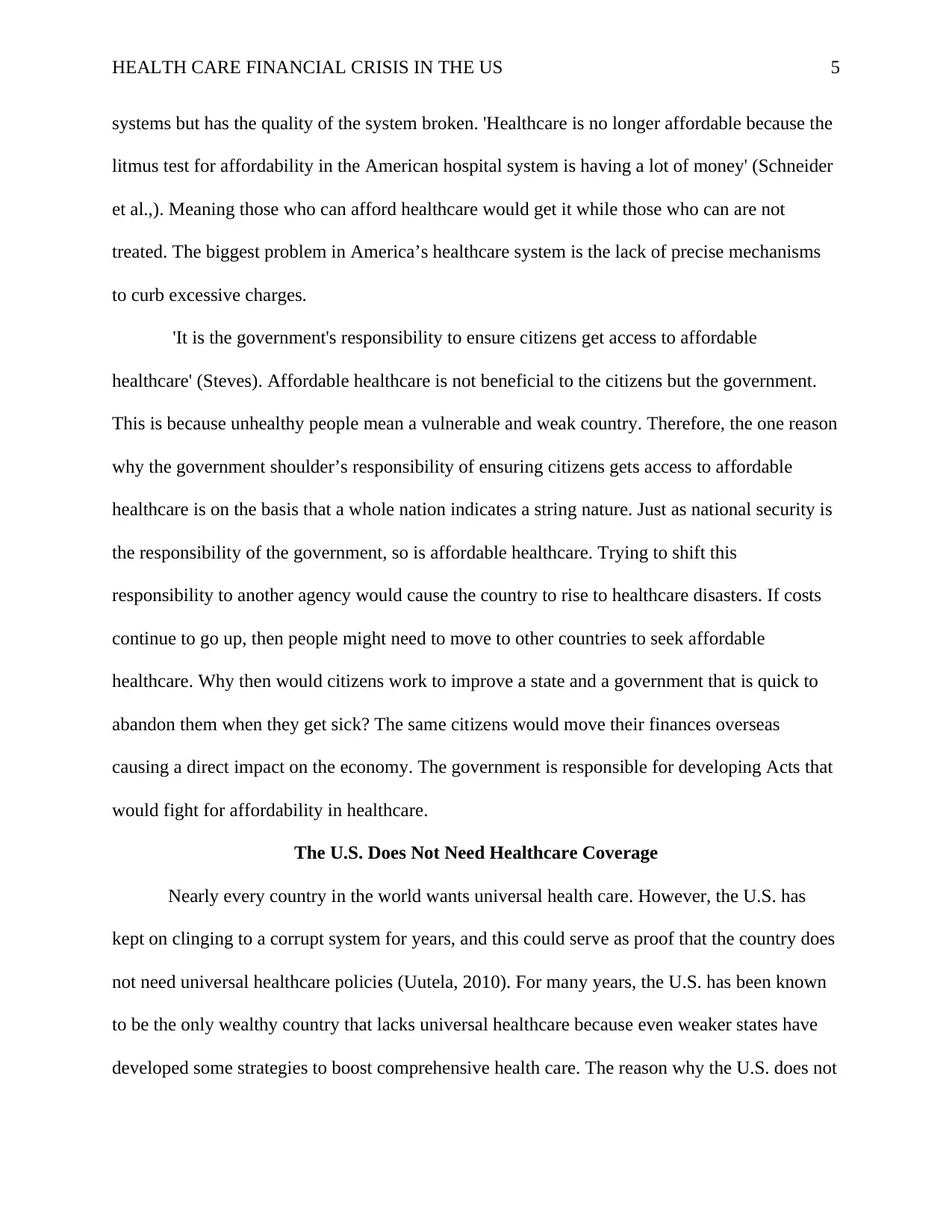
HEALTH CARE FINANCIAL CRISIS IN THE US 5
systems but has the quality of the system broken. 'Healthcare is no longer affordable because the
litmus test for affordability in the American hospital system is having a lot of money' (Schneider
et al.,). Meaning those who can afford healthcare would get it while those who can are not
treated. The biggest problem in America’s healthcare system is the lack of precise mechanisms
to curb excessive charges.
'It is the government's responsibility to ensure citizens get access to affordable
healthcare' (Steves). Affordable healthcare is not beneficial to the citizens but the government.
This is because unhealthy people mean a vulnerable and weak country. Therefore, the one reason
why the government shoulder’s responsibility of ensuring citizens gets access to affordable
healthcare is on the basis that a whole nation indicates a string nature. Just as national security is
the responsibility of the government, so is affordable healthcare. Trying to shift this
responsibility to another agency would cause the country to rise to healthcare disasters. If costs
continue to go up, then people might need to move to other countries to seek affordable
healthcare. Why then would citizens work to improve a state and a government that is quick to
abandon them when they get sick? The same citizens would move their finances overseas
causing a direct impact on the economy. The government is responsible for developing Acts that
would fight for affordability in healthcare.
The U.S. Does Not Need Healthcare Coverage
Nearly every country in the world wants universal health care. However, the U.S. has
kept on clinging to a corrupt system for years, and this could serve as proof that the country does
not need universal healthcare policies (Uutela, 2010). For many years, the U.S. has been known
to be the only wealthy country that lacks universal healthcare because even weaker states have
developed some strategies to boost comprehensive health care. The reason why the U.S. does not
systems but has the quality of the system broken. 'Healthcare is no longer affordable because the
litmus test for affordability in the American hospital system is having a lot of money' (Schneider
et al.,). Meaning those who can afford healthcare would get it while those who can are not
treated. The biggest problem in America’s healthcare system is the lack of precise mechanisms
to curb excessive charges.
'It is the government's responsibility to ensure citizens get access to affordable
healthcare' (Steves). Affordable healthcare is not beneficial to the citizens but the government.
This is because unhealthy people mean a vulnerable and weak country. Therefore, the one reason
why the government shoulder’s responsibility of ensuring citizens gets access to affordable
healthcare is on the basis that a whole nation indicates a string nature. Just as national security is
the responsibility of the government, so is affordable healthcare. Trying to shift this
responsibility to another agency would cause the country to rise to healthcare disasters. If costs
continue to go up, then people might need to move to other countries to seek affordable
healthcare. Why then would citizens work to improve a state and a government that is quick to
abandon them when they get sick? The same citizens would move their finances overseas
causing a direct impact on the economy. The government is responsible for developing Acts that
would fight for affordability in healthcare.
The U.S. Does Not Need Healthcare Coverage
Nearly every country in the world wants universal health care. However, the U.S. has
kept on clinging to a corrupt system for years, and this could serve as proof that the country does
not need universal healthcare policies (Uutela, 2010). For many years, the U.S. has been known
to be the only wealthy country that lacks universal healthcare because even weaker states have
developed some strategies to boost comprehensive health care. The reason why the U.S. does not

HEALTH CARE FINANCIAL CRISIS IN THE US 6
need a universal healthcare system is partly due to cultural reasons. Cultural reasons as to why
America does not provide universal healthcare are; the country's dedication to a free market
system, the idea of individualism and also the belief in personal responsibility. Absence of a
comprehensive healthcare system would be an actual step to have the country move towards
high-level implementation of a free-market system. The country's ideas of individualism also
make up the reasons as to why America does not need a universal plan. In fact, in current
America, 'the creation of a system that unites citizens is considered entirely accidental' because
like it is, everyone should live independent from the other in the U.S.
Universal Health Care Cut Down on Private Insurance
As mentioned earlier in the benefits of universal health care section, such a plan
eliminates administrative costs of having to deal with different private health insurance
companies. This means that 'comprehensive coverage could do away with individual insurance
plans'. Understanding how universal health care is financed is critical in realizing how citizens
might do away with private insurance (Stuckler et.al 2013). To begin with, universal health care
is funded from sharing resources to spread the financial risks of the ailing population across a
broader community. In this system, a large pool is created to collect prepaid funds that can be
used to cover any health care costs of the needy regardless of how they can pay.
Looking at countries that have managed to adopt such a system, these nations have
progressed because they have managed to implement coverage after making it mandatory for
citizens through taxation. How then can an individual who is already being taxed and earning
less seek services from a private insurance company? With compulsory contributions and the
spread of risks, universal health care reduces citizens’ reliance on private insurance services
need a universal healthcare system is partly due to cultural reasons. Cultural reasons as to why
America does not provide universal healthcare are; the country's dedication to a free market
system, the idea of individualism and also the belief in personal responsibility. Absence of a
comprehensive healthcare system would be an actual step to have the country move towards
high-level implementation of a free-market system. The country's ideas of individualism also
make up the reasons as to why America does not need a universal plan. In fact, in current
America, 'the creation of a system that unites citizens is considered entirely accidental' because
like it is, everyone should live independent from the other in the U.S.
Universal Health Care Cut Down on Private Insurance
As mentioned earlier in the benefits of universal health care section, such a plan
eliminates administrative costs of having to deal with different private health insurance
companies. This means that 'comprehensive coverage could do away with individual insurance
plans'. Understanding how universal health care is financed is critical in realizing how citizens
might do away with private insurance (Stuckler et.al 2013). To begin with, universal health care
is funded from sharing resources to spread the financial risks of the ailing population across a
broader community. In this system, a large pool is created to collect prepaid funds that can be
used to cover any health care costs of the needy regardless of how they can pay.
Looking at countries that have managed to adopt such a system, these nations have
progressed because they have managed to implement coverage after making it mandatory for
citizens through taxation. How then can an individual who is already being taxed and earning
less seek services from a private insurance company? With compulsory contributions and the
spread of risks, universal health care reduces citizens’ reliance on private insurance services
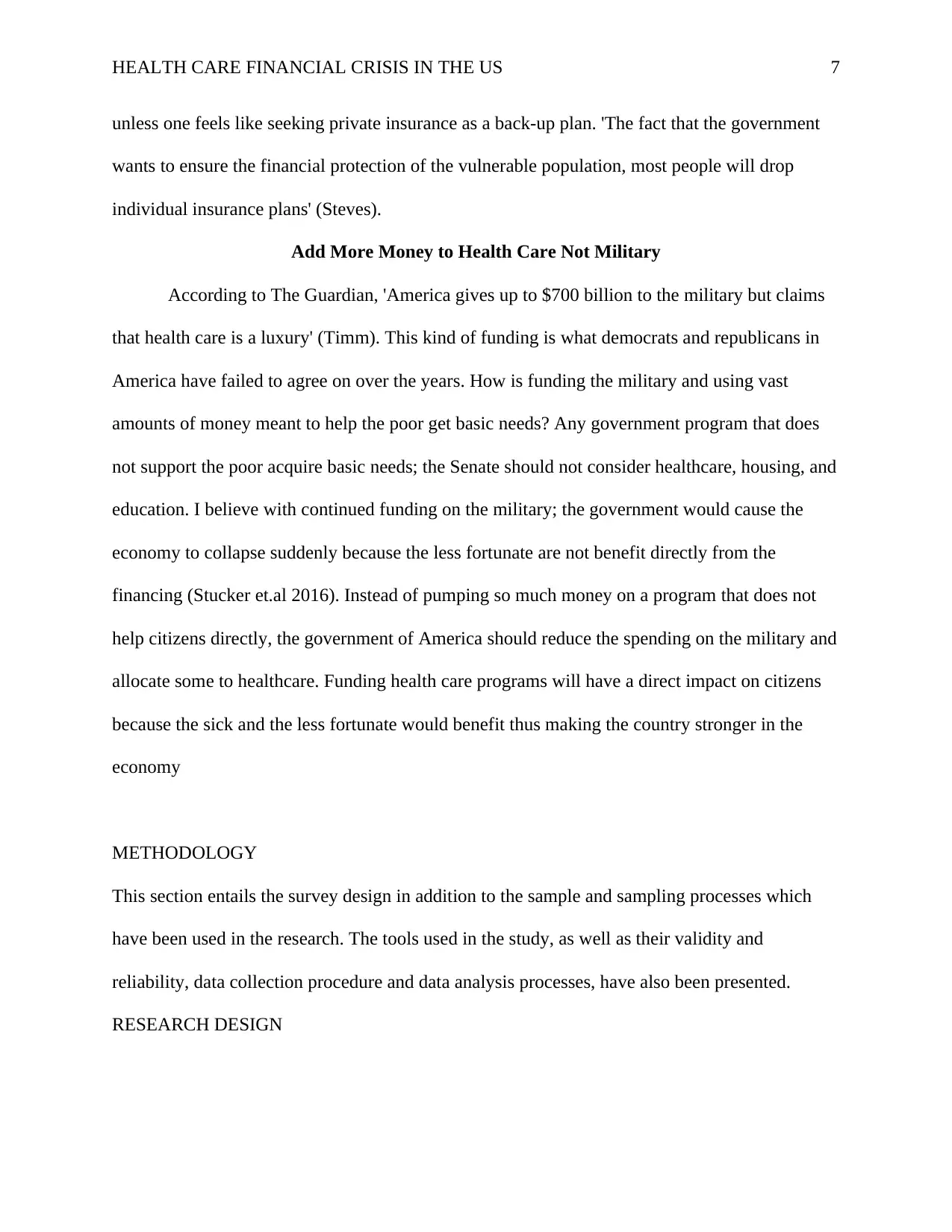
HEALTH CARE FINANCIAL CRISIS IN THE US 7
unless one feels like seeking private insurance as a back-up plan. 'The fact that the government
wants to ensure the financial protection of the vulnerable population, most people will drop
individual insurance plans' (Steves).
Add More Money to Health Care Not Military
According to The Guardian, 'America gives up to $700 billion to the military but claims
that health care is a luxury' (Timm). This kind of funding is what democrats and republicans in
America have failed to agree on over the years. How is funding the military and using vast
amounts of money meant to help the poor get basic needs? Any government program that does
not support the poor acquire basic needs; the Senate should not consider healthcare, housing, and
education. I believe with continued funding on the military; the government would cause the
economy to collapse suddenly because the less fortunate are not benefit directly from the
financing (Stucker et.al 2016). Instead of pumping so much money on a program that does not
help citizens directly, the government of America should reduce the spending on the military and
allocate some to healthcare. Funding health care programs will have a direct impact on citizens
because the sick and the less fortunate would benefit thus making the country stronger in the
economy
METHODOLOGY
This section entails the survey design in addition to the sample and sampling processes which
have been used in the research. The tools used in the study, as well as their validity and
reliability, data collection procedure and data analysis processes, have also been presented.
RESEARCH DESIGN
unless one feels like seeking private insurance as a back-up plan. 'The fact that the government
wants to ensure the financial protection of the vulnerable population, most people will drop
individual insurance plans' (Steves).
Add More Money to Health Care Not Military
According to The Guardian, 'America gives up to $700 billion to the military but claims
that health care is a luxury' (Timm). This kind of funding is what democrats and republicans in
America have failed to agree on over the years. How is funding the military and using vast
amounts of money meant to help the poor get basic needs? Any government program that does
not support the poor acquire basic needs; the Senate should not consider healthcare, housing, and
education. I believe with continued funding on the military; the government would cause the
economy to collapse suddenly because the less fortunate are not benefit directly from the
financing (Stucker et.al 2016). Instead of pumping so much money on a program that does not
help citizens directly, the government of America should reduce the spending on the military and
allocate some to healthcare. Funding health care programs will have a direct impact on citizens
because the sick and the less fortunate would benefit thus making the country stronger in the
economy
METHODOLOGY
This section entails the survey design in addition to the sample and sampling processes which
have been used in the research. The tools used in the study, as well as their validity and
reliability, data collection procedure and data analysis processes, have also been presented.
RESEARCH DESIGN
Paraphrase This Document
Need a fresh take? Get an instant paraphrase of this document with our AI Paraphraser
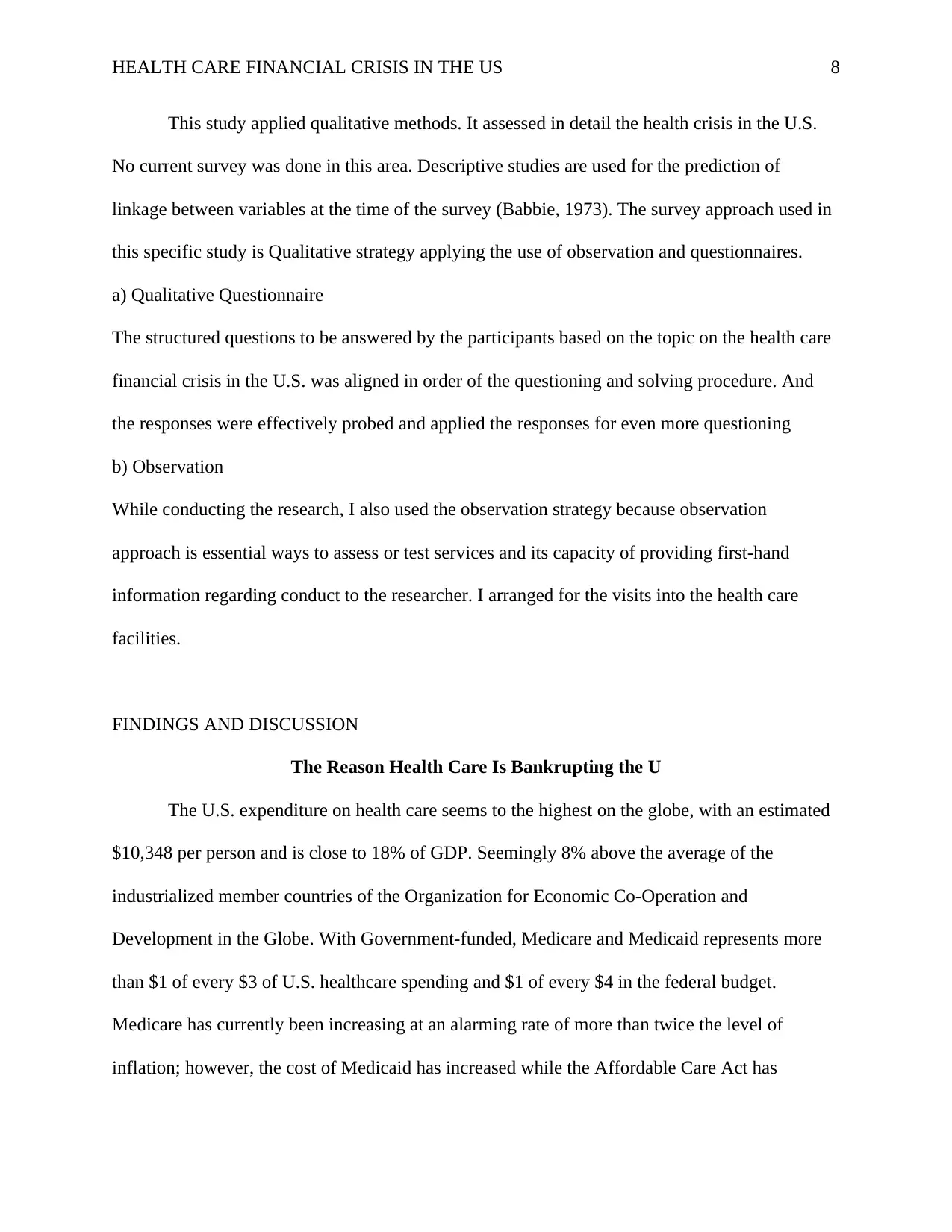
HEALTH CARE FINANCIAL CRISIS IN THE US 8
This study applied qualitative methods. It assessed in detail the health crisis in the U.S.
No current survey was done in this area. Descriptive studies are used for the prediction of
linkage between variables at the time of the survey (Babbie, 1973). The survey approach used in
this specific study is Qualitative strategy applying the use of observation and questionnaires.
a) Qualitative Questionnaire
The structured questions to be answered by the participants based on the topic on the health care
financial crisis in the U.S. was aligned in order of the questioning and solving procedure. And
the responses were effectively probed and applied the responses for even more questioning
b) Observation
While conducting the research, I also used the observation strategy because observation
approach is essential ways to assess or test services and its capacity of providing first-hand
information regarding conduct to the researcher. I arranged for the visits into the health care
facilities.
FINDINGS AND DISCUSSION
The Reason Health Care Is Bankrupting the U
The U.S. expenditure on health care seems to the highest on the globe, with an estimated
$10,348 per person and is close to 18% of GDP. Seemingly 8% above the average of the
industrialized member countries of the Organization for Economic Co-Operation and
Development in the Globe. With Government-funded, Medicare and Medicaid represents more
than $1 of every $3 of U.S. healthcare spending and $1 of every $4 in the federal budget.
Medicare has currently been increasing at an alarming rate of more than twice the level of
inflation; however, the cost of Medicaid has increased while the Affordable Care Act has
This study applied qualitative methods. It assessed in detail the health crisis in the U.S.
No current survey was done in this area. Descriptive studies are used for the prediction of
linkage between variables at the time of the survey (Babbie, 1973). The survey approach used in
this specific study is Qualitative strategy applying the use of observation and questionnaires.
a) Qualitative Questionnaire
The structured questions to be answered by the participants based on the topic on the health care
financial crisis in the U.S. was aligned in order of the questioning and solving procedure. And
the responses were effectively probed and applied the responses for even more questioning
b) Observation
While conducting the research, I also used the observation strategy because observation
approach is essential ways to assess or test services and its capacity of providing first-hand
information regarding conduct to the researcher. I arranged for the visits into the health care
facilities.
FINDINGS AND DISCUSSION
The Reason Health Care Is Bankrupting the U
The U.S. expenditure on health care seems to the highest on the globe, with an estimated
$10,348 per person and is close to 18% of GDP. Seemingly 8% above the average of the
industrialized member countries of the Organization for Economic Co-Operation and
Development in the Globe. With Government-funded, Medicare and Medicaid represents more
than $1 of every $3 of U.S. healthcare spending and $1 of every $4 in the federal budget.
Medicare has currently been increasing at an alarming rate of more than twice the level of
inflation; however, the cost of Medicaid has increased while the Affordable Care Act has
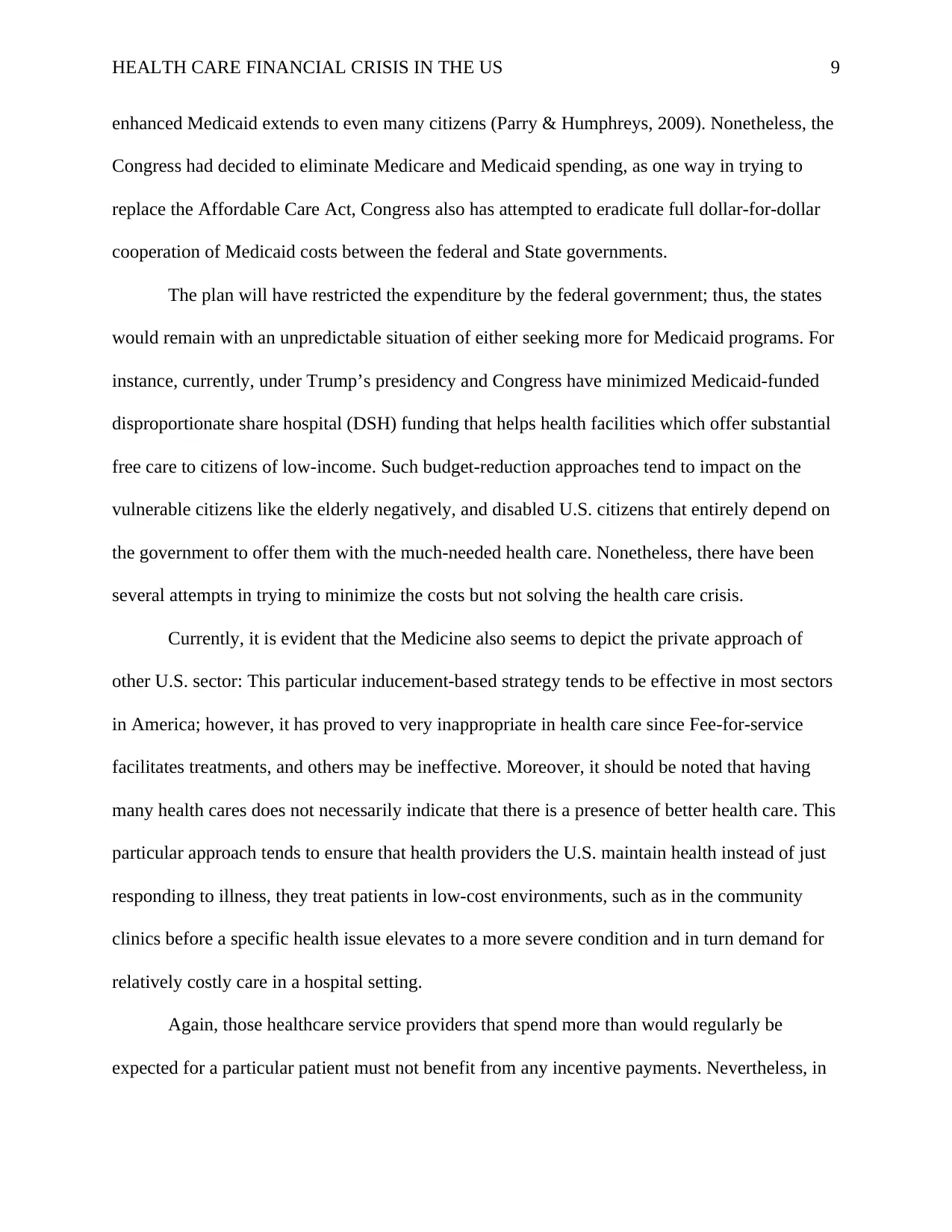
HEALTH CARE FINANCIAL CRISIS IN THE US 9
enhanced Medicaid extends to even many citizens (Parry & Humphreys, 2009). Nonetheless, the
Congress had decided to eliminate Medicare and Medicaid spending, as one way in trying to
replace the Affordable Care Act, Congress also has attempted to eradicate full dollar-for-dollar
cooperation of Medicaid costs between the federal and State governments.
The plan will have restricted the expenditure by the federal government; thus, the states
would remain with an unpredictable situation of either seeking more for Medicaid programs. For
instance, currently, under Trump’s presidency and Congress have minimized Medicaid-funded
disproportionate share hospital (DSH) funding that helps health facilities which offer substantial
free care to citizens of low-income. Such budget-reduction approaches tend to impact on the
vulnerable citizens like the elderly negatively, and disabled U.S. citizens that entirely depend on
the government to offer them with the much-needed health care. Nonetheless, there have been
several attempts in trying to minimize the costs but not solving the health care crisis.
Currently, it is evident that the Medicine also seems to depict the private approach of
other U.S. sector: This particular inducement-based strategy tends to be effective in most sectors
in America; however, it has proved to very inappropriate in health care since Fee-for-service
facilitates treatments, and others may be ineffective. Moreover, it should be noted that having
many health cares does not necessarily indicate that there is a presence of better health care. This
particular approach tends to ensure that health providers the U.S. maintain health instead of just
responding to illness, they treat patients in low-cost environments, such as in the community
clinics before a specific health issue elevates to a more severe condition and in turn demand for
relatively costly care in a hospital setting.
Again, those healthcare service providers that spend more than would regularly be
expected for a particular patient must not benefit from any incentive payments. Nevertheless, in
enhanced Medicaid extends to even many citizens (Parry & Humphreys, 2009). Nonetheless, the
Congress had decided to eliminate Medicare and Medicaid spending, as one way in trying to
replace the Affordable Care Act, Congress also has attempted to eradicate full dollar-for-dollar
cooperation of Medicaid costs between the federal and State governments.
The plan will have restricted the expenditure by the federal government; thus, the states
would remain with an unpredictable situation of either seeking more for Medicaid programs. For
instance, currently, under Trump’s presidency and Congress have minimized Medicaid-funded
disproportionate share hospital (DSH) funding that helps health facilities which offer substantial
free care to citizens of low-income. Such budget-reduction approaches tend to impact on the
vulnerable citizens like the elderly negatively, and disabled U.S. citizens that entirely depend on
the government to offer them with the much-needed health care. Nonetheless, there have been
several attempts in trying to minimize the costs but not solving the health care crisis.
Currently, it is evident that the Medicine also seems to depict the private approach of
other U.S. sector: This particular inducement-based strategy tends to be effective in most sectors
in America; however, it has proved to very inappropriate in health care since Fee-for-service
facilitates treatments, and others may be ineffective. Moreover, it should be noted that having
many health cares does not necessarily indicate that there is a presence of better health care. This
particular approach tends to ensure that health providers the U.S. maintain health instead of just
responding to illness, they treat patients in low-cost environments, such as in the community
clinics before a specific health issue elevates to a more severe condition and in turn demand for
relatively costly care in a hospital setting.
Again, those healthcare service providers that spend more than would regularly be
expected for a particular patient must not benefit from any incentive payments. Nevertheless, in
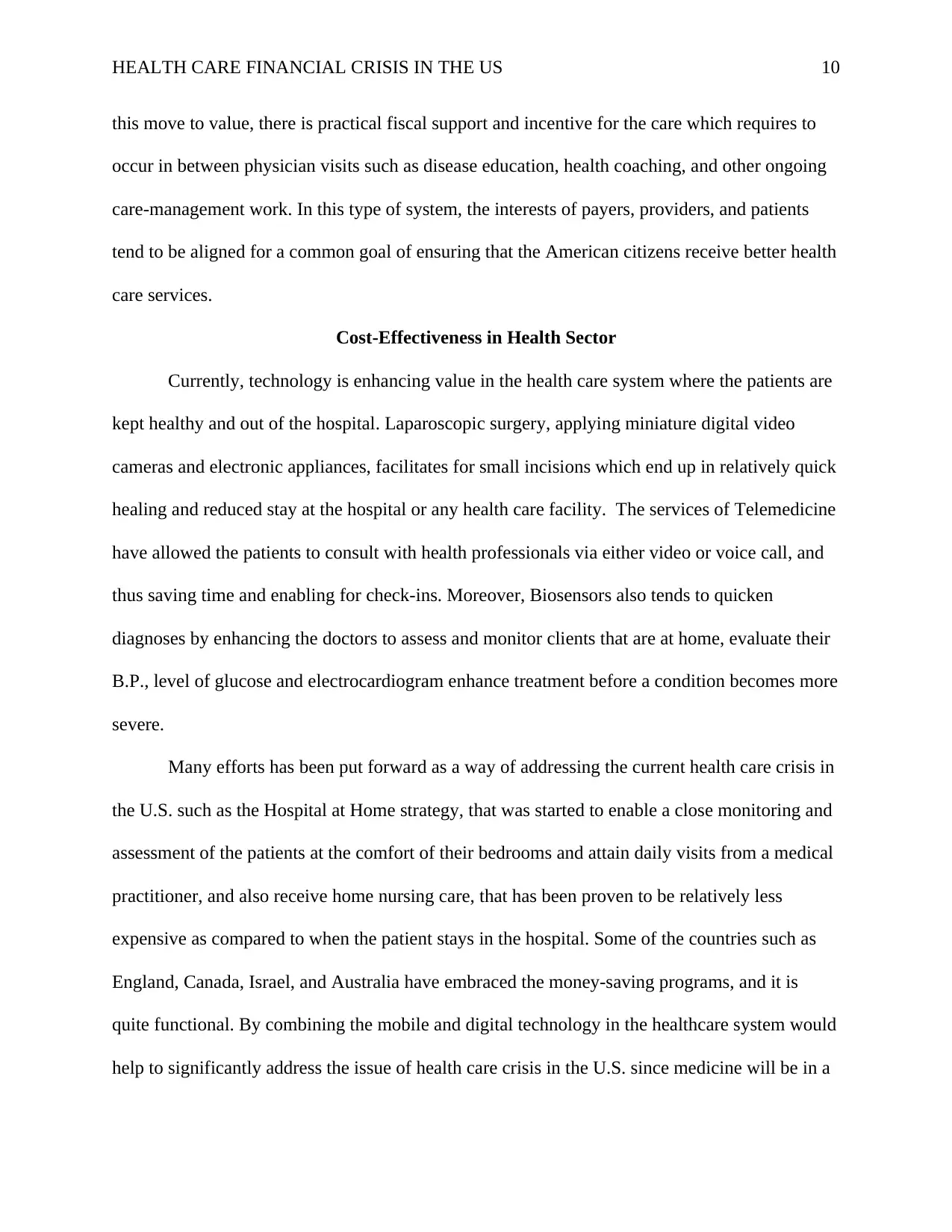
HEALTH CARE FINANCIAL CRISIS IN THE US 10
this move to value, there is practical fiscal support and incentive for the care which requires to
occur in between physician visits such as disease education, health coaching, and other ongoing
care-management work. In this type of system, the interests of payers, providers, and patients
tend to be aligned for a common goal of ensuring that the American citizens receive better health
care services.
Cost-Effectiveness in Health Sector
Currently, technology is enhancing value in the health care system where the patients are
kept healthy and out of the hospital. Laparoscopic surgery, applying miniature digital video
cameras and electronic appliances, facilitates for small incisions which end up in relatively quick
healing and reduced stay at the hospital or any health care facility. The services of Telemedicine
have allowed the patients to consult with health professionals via either video or voice call, and
thus saving time and enabling for check-ins. Moreover, Biosensors also tends to quicken
diagnoses by enhancing the doctors to assess and monitor clients that are at home, evaluate their
B.P., level of glucose and electrocardiogram enhance treatment before a condition becomes more
severe.
Many efforts has been put forward as a way of addressing the current health care crisis in
the U.S. such as the Hospital at Home strategy, that was started to enable a close monitoring and
assessment of the patients at the comfort of their bedrooms and attain daily visits from a medical
practitioner, and also receive home nursing care, that has been proven to be relatively less
expensive as compared to when the patient stays in the hospital. Some of the countries such as
England, Canada, Israel, and Australia have embraced the money-saving programs, and it is
quite functional. By combining the mobile and digital technology in the healthcare system would
help to significantly address the issue of health care crisis in the U.S. since medicine will be in a
this move to value, there is practical fiscal support and incentive for the care which requires to
occur in between physician visits such as disease education, health coaching, and other ongoing
care-management work. In this type of system, the interests of payers, providers, and patients
tend to be aligned for a common goal of ensuring that the American citizens receive better health
care services.
Cost-Effectiveness in Health Sector
Currently, technology is enhancing value in the health care system where the patients are
kept healthy and out of the hospital. Laparoscopic surgery, applying miniature digital video
cameras and electronic appliances, facilitates for small incisions which end up in relatively quick
healing and reduced stay at the hospital or any health care facility. The services of Telemedicine
have allowed the patients to consult with health professionals via either video or voice call, and
thus saving time and enabling for check-ins. Moreover, Biosensors also tends to quicken
diagnoses by enhancing the doctors to assess and monitor clients that are at home, evaluate their
B.P., level of glucose and electrocardiogram enhance treatment before a condition becomes more
severe.
Many efforts has been put forward as a way of addressing the current health care crisis in
the U.S. such as the Hospital at Home strategy, that was started to enable a close monitoring and
assessment of the patients at the comfort of their bedrooms and attain daily visits from a medical
practitioner, and also receive home nursing care, that has been proven to be relatively less
expensive as compared to when the patient stays in the hospital. Some of the countries such as
England, Canada, Israel, and Australia have embraced the money-saving programs, and it is
quite functional. By combining the mobile and digital technology in the healthcare system would
help to significantly address the issue of health care crisis in the U.S. since medicine will be in a
Secure Best Marks with AI Grader
Need help grading? Try our AI Grader for instant feedback on your assignments.

HEALTH CARE FINANCIAL CRISIS IN THE US 11
position to reduce the figure of hospital admissions and in turn minimize on the costly
readmissions.
Moreover, as hospital visits tend to reduce and surgical outpatient process improve, there
is a likelihood that the hospital bed demand will decrease and more need to expand and facilitate
mobile services. Nevertheless, hospitals are to create more of the community medical practices
and outpatient surgery centres, which are required for more value-oriented care. However, the
full-service hospitals need to not to be eliminated but rather should also be a significant area of
focus since it would be necessary for the individual who is experiencing a relatively more
complicated medical condition (Marmot & Bell, 2009). Shifts in the U.S. health care had a
significant focus on enhancing the value of health care as one of the primary means of addressing
the health care crisis that has been in existence for decades from one administration to the other.
There is much need for the move since it is evident that the current fee-for-service
strategy is becoming ineffective. There is a requirement for the payment approach, which will be
favourable for health care providers, patients and even the payers. Instead of unsystematic cost
reduction, value-based care tends to be the best strategy to enhance the healthcare cost curve
since it is likely to strengthen the health of the patient and the general nation's fiscal and
economic health. It is evident that community health centers seem to save, on average, $2,371
per Medicaid patient and up to $1,210 per Medicare patient. They produce over $20bn in savings
to the overall national healthcare system. The community health centers assist individuals in
maintaining and enhancing public health and emphasizing on primary care which is reasonably
priced, and as a result, help individuals to prevent bankruptcy due to the affordability of medical
expenses.
position to reduce the figure of hospital admissions and in turn minimize on the costly
readmissions.
Moreover, as hospital visits tend to reduce and surgical outpatient process improve, there
is a likelihood that the hospital bed demand will decrease and more need to expand and facilitate
mobile services. Nevertheless, hospitals are to create more of the community medical practices
and outpatient surgery centres, which are required for more value-oriented care. However, the
full-service hospitals need to not to be eliminated but rather should also be a significant area of
focus since it would be necessary for the individual who is experiencing a relatively more
complicated medical condition (Marmot & Bell, 2009). Shifts in the U.S. health care had a
significant focus on enhancing the value of health care as one of the primary means of addressing
the health care crisis that has been in existence for decades from one administration to the other.
There is much need for the move since it is evident that the current fee-for-service
strategy is becoming ineffective. There is a requirement for the payment approach, which will be
favourable for health care providers, patients and even the payers. Instead of unsystematic cost
reduction, value-based care tends to be the best strategy to enhance the healthcare cost curve
since it is likely to strengthen the health of the patient and the general nation's fiscal and
economic health. It is evident that community health centers seem to save, on average, $2,371
per Medicaid patient and up to $1,210 per Medicare patient. They produce over $20bn in savings
to the overall national healthcare system. The community health centers assist individuals in
maintaining and enhancing public health and emphasizing on primary care which is reasonably
priced, and as a result, help individuals to prevent bankruptcy due to the affordability of medical
expenses.
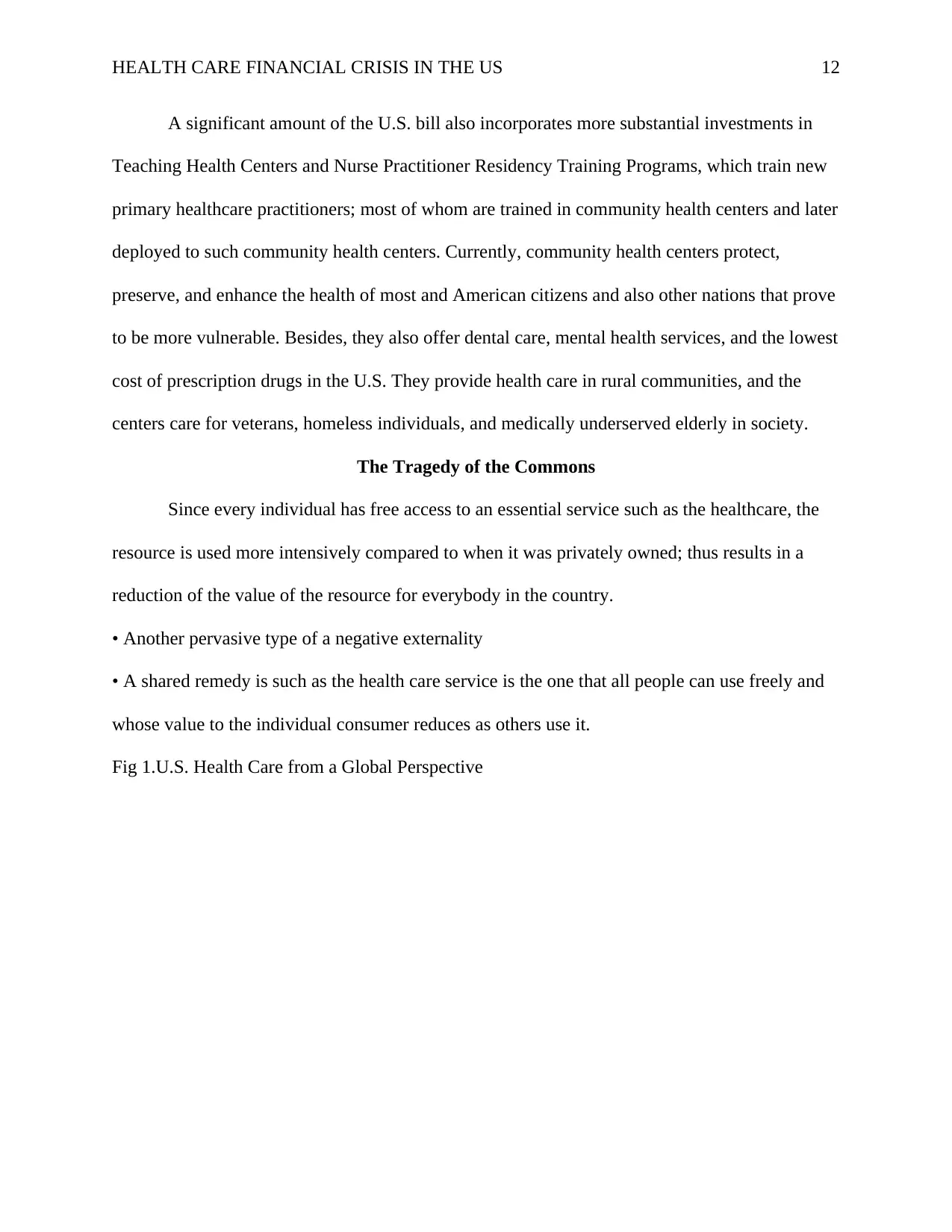
HEALTH CARE FINANCIAL CRISIS IN THE US 12
A significant amount of the U.S. bill also incorporates more substantial investments in
Teaching Health Centers and Nurse Practitioner Residency Training Programs, which train new
primary healthcare practitioners; most of whom are trained in community health centers and later
deployed to such community health centers. Currently, community health centers protect,
preserve, and enhance the health of most and American citizens and also other nations that prove
to be more vulnerable. Besides, they also offer dental care, mental health services, and the lowest
cost of prescription drugs in the U.S. They provide health care in rural communities, and the
centers care for veterans, homeless individuals, and medically underserved elderly in society.
The Tragedy of the Commons
Since every individual has free access to an essential service such as the healthcare, the
resource is used more intensively compared to when it was privately owned; thus results in a
reduction of the value of the resource for everybody in the country.
• Another pervasive type of a negative externality
• A shared remedy is such as the health care service is the one that all people can use freely and
whose value to the individual consumer reduces as others use it.
Fig 1.U.S. Health Care from a Global Perspective
A significant amount of the U.S. bill also incorporates more substantial investments in
Teaching Health Centers and Nurse Practitioner Residency Training Programs, which train new
primary healthcare practitioners; most of whom are trained in community health centers and later
deployed to such community health centers. Currently, community health centers protect,
preserve, and enhance the health of most and American citizens and also other nations that prove
to be more vulnerable. Besides, they also offer dental care, mental health services, and the lowest
cost of prescription drugs in the U.S. They provide health care in rural communities, and the
centers care for veterans, homeless individuals, and medically underserved elderly in society.
The Tragedy of the Commons
Since every individual has free access to an essential service such as the healthcare, the
resource is used more intensively compared to when it was privately owned; thus results in a
reduction of the value of the resource for everybody in the country.
• Another pervasive type of a negative externality
• A shared remedy is such as the health care service is the one that all people can use freely and
whose value to the individual consumer reduces as others use it.
Fig 1.U.S. Health Care from a Global Perspective
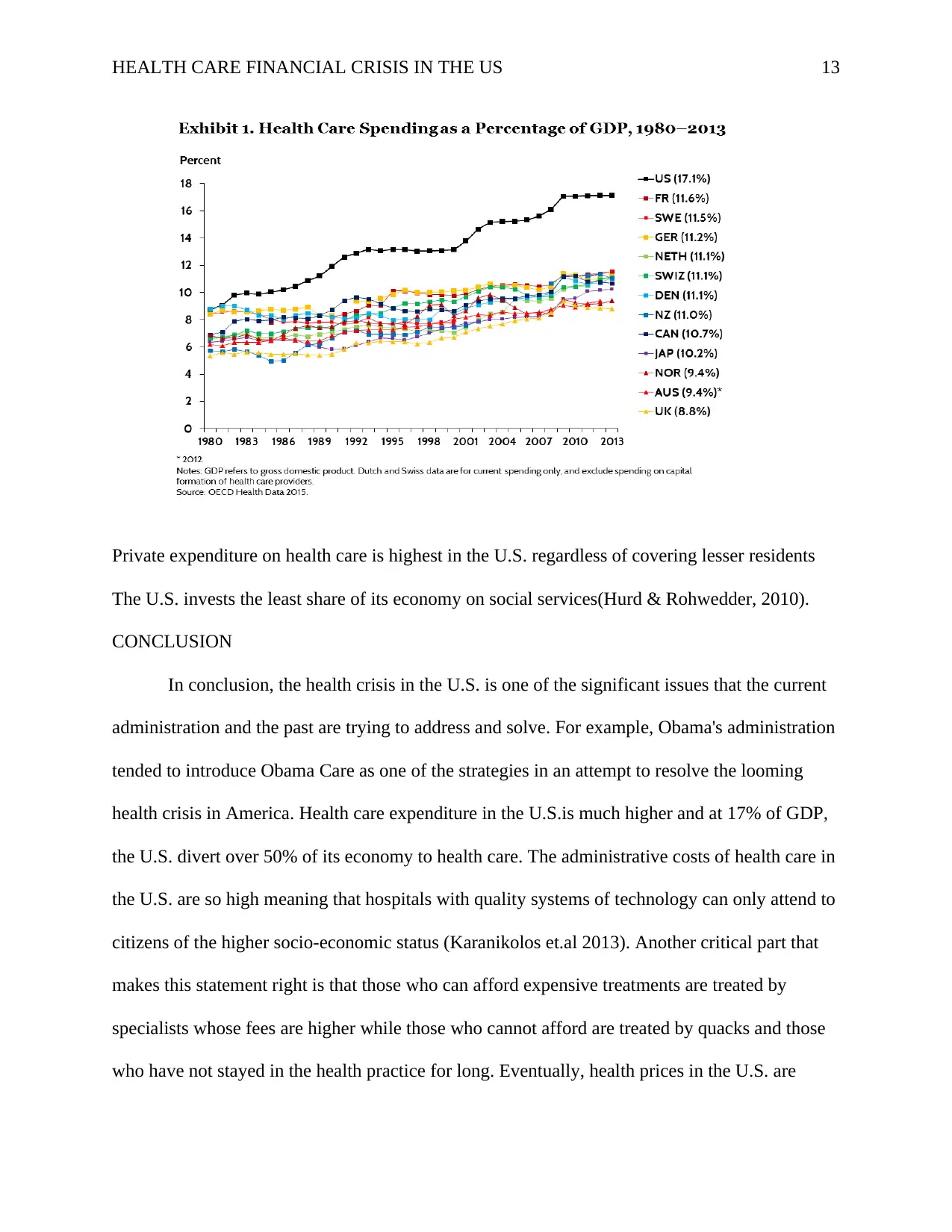
HEALTH CARE FINANCIAL CRISIS IN THE US 13
Private expenditure on health care is highest in the U.S. regardless of covering lesser residents
The U.S. invests the least share of its economy on social services(Hurd & Rohwedder, 2010).
CONCLUSION
In conclusion, the health crisis in the U.S. is one of the significant issues that the current
administration and the past are trying to address and solve. For example, Obama's administration
tended to introduce Obama Care as one of the strategies in an attempt to resolve the looming
health crisis in America. Health care expenditure in the U.S.is much higher and at 17% of GDP,
the U.S. divert over 50% of its economy to health care. The administrative costs of health care in
the U.S. are so high meaning that hospitals with quality systems of technology can only attend to
citizens of the higher socio-economic status (Karanikolos et.al 2013). Another critical part that
makes this statement right is that those who can afford expensive treatments are treated by
specialists whose fees are higher while those who cannot afford are treated by quacks and those
who have not stayed in the health practice for long. Eventually, health prices in the U.S. are
Private expenditure on health care is highest in the U.S. regardless of covering lesser residents
The U.S. invests the least share of its economy on social services(Hurd & Rohwedder, 2010).
CONCLUSION
In conclusion, the health crisis in the U.S. is one of the significant issues that the current
administration and the past are trying to address and solve. For example, Obama's administration
tended to introduce Obama Care as one of the strategies in an attempt to resolve the looming
health crisis in America. Health care expenditure in the U.S.is much higher and at 17% of GDP,
the U.S. divert over 50% of its economy to health care. The administrative costs of health care in
the U.S. are so high meaning that hospitals with quality systems of technology can only attend to
citizens of the higher socio-economic status (Karanikolos et.al 2013). Another critical part that
makes this statement right is that those who can afford expensive treatments are treated by
specialists whose fees are higher while those who cannot afford are treated by quacks and those
who have not stayed in the health practice for long. Eventually, health prices in the U.S. are
Paraphrase This Document
Need a fresh take? Get an instant paraphrase of this document with our AI Paraphraser

HEALTH CARE FINANCIAL CRISIS IN THE US 14
dependent on who the payer is. If a section of individuals from the high socio-economic class
demand high rates, the one behind the prestigious brand approves. In a more extensive part of the
U.S. healthcare market, prestigious medical institutions are allowed to quote the price for
treatment, drugs, consultation and other services which makes affordability hard for an ordinary
citizen.
dependent on who the payer is. If a section of individuals from the high socio-economic class
demand high rates, the one behind the prestigious brand approves. In a more extensive part of the
U.S. healthcare market, prestigious medical institutions are allowed to quote the price for
treatment, drugs, consultation and other services which makes affordability hard for an ordinary
citizen.
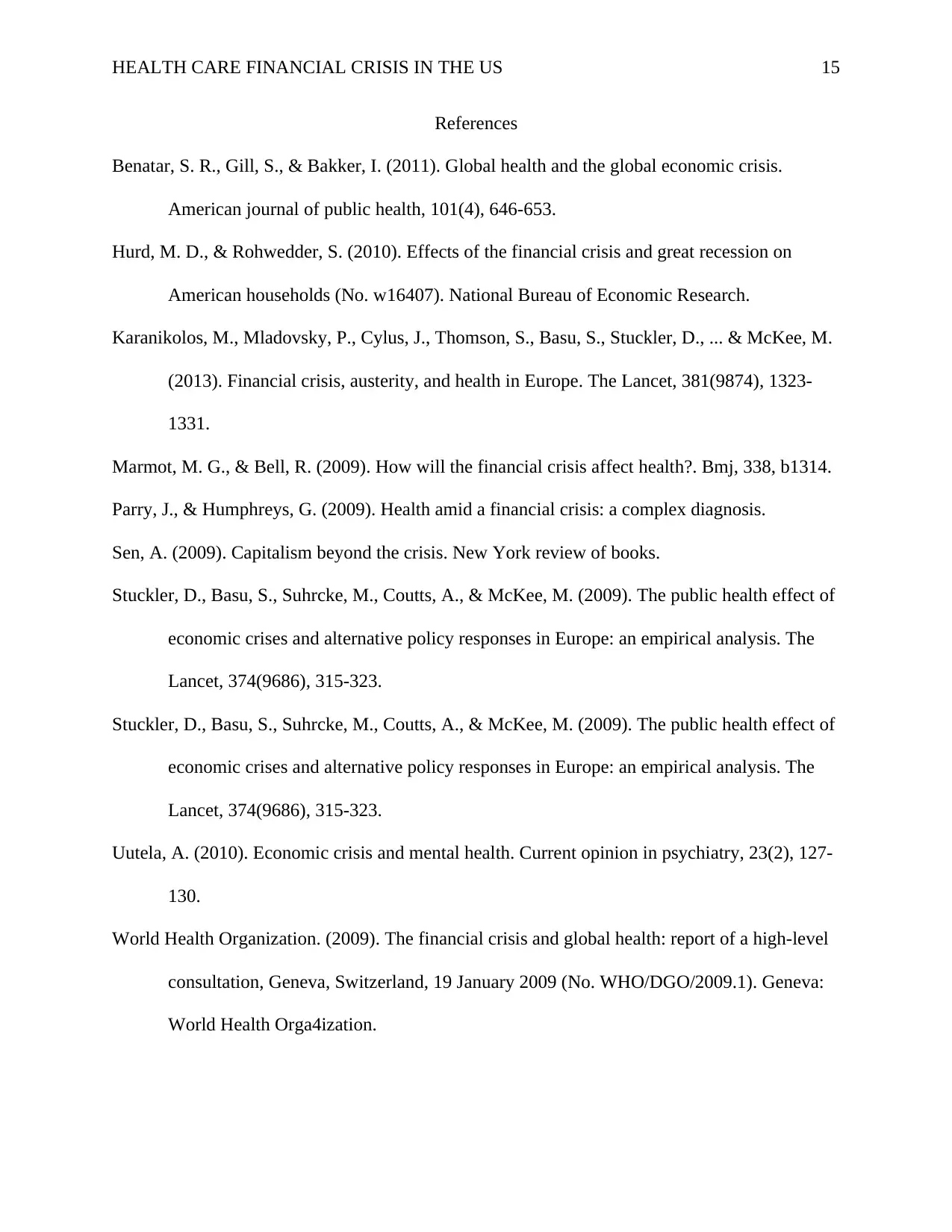
HEALTH CARE FINANCIAL CRISIS IN THE US 15
References
Benatar, S. R., Gill, S., & Bakker, I. (2011). Global health and the global economic crisis.
American journal of public health, 101(4), 646-653.
Hurd, M. D., & Rohwedder, S. (2010). Effects of the financial crisis and great recession on
American households (No. w16407). National Bureau of Economic Research.
Karanikolos, M., Mladovsky, P., Cylus, J., Thomson, S., Basu, S., Stuckler, D., ... & McKee, M.
(2013). Financial crisis, austerity, and health in Europe. The Lancet, 381(9874), 1323-
1331.
Marmot, M. G., & Bell, R. (2009). How will the financial crisis affect health?. Bmj, 338, b1314.
Parry, J., & Humphreys, G. (2009). Health amid a financial crisis: a complex diagnosis.
Sen, A. (2009). Capitalism beyond the crisis. New York review of books.
Stuckler, D., Basu, S., Suhrcke, M., Coutts, A., & McKee, M. (2009). The public health effect of
economic crises and alternative policy responses in Europe: an empirical analysis. The
Lancet, 374(9686), 315-323.
Stuckler, D., Basu, S., Suhrcke, M., Coutts, A., & McKee, M. (2009). The public health effect of
economic crises and alternative policy responses in Europe: an empirical analysis. The
Lancet, 374(9686), 315-323.
Uutela, A. (2010). Economic crisis and mental health. Current opinion in psychiatry, 23(2), 127-
130.
World Health Organization. (2009). The financial crisis and global health: report of a high-level
consultation, Geneva, Switzerland, 19 January 2009 (No. WHO/DGO/2009.1). Geneva:
World Health Orga4ization.
References
Benatar, S. R., Gill, S., & Bakker, I. (2011). Global health and the global economic crisis.
American journal of public health, 101(4), 646-653.
Hurd, M. D., & Rohwedder, S. (2010). Effects of the financial crisis and great recession on
American households (No. w16407). National Bureau of Economic Research.
Karanikolos, M., Mladovsky, P., Cylus, J., Thomson, S., Basu, S., Stuckler, D., ... & McKee, M.
(2013). Financial crisis, austerity, and health in Europe. The Lancet, 381(9874), 1323-
1331.
Marmot, M. G., & Bell, R. (2009). How will the financial crisis affect health?. Bmj, 338, b1314.
Parry, J., & Humphreys, G. (2009). Health amid a financial crisis: a complex diagnosis.
Sen, A. (2009). Capitalism beyond the crisis. New York review of books.
Stuckler, D., Basu, S., Suhrcke, M., Coutts, A., & McKee, M. (2009). The public health effect of
economic crises and alternative policy responses in Europe: an empirical analysis. The
Lancet, 374(9686), 315-323.
Stuckler, D., Basu, S., Suhrcke, M., Coutts, A., & McKee, M. (2009). The public health effect of
economic crises and alternative policy responses in Europe: an empirical analysis. The
Lancet, 374(9686), 315-323.
Uutela, A. (2010). Economic crisis and mental health. Current opinion in psychiatry, 23(2), 127-
130.
World Health Organization. (2009). The financial crisis and global health: report of a high-level
consultation, Geneva, Switzerland, 19 January 2009 (No. WHO/DGO/2009.1). Geneva:
World Health Orga4ization.
1 out of 15
Related Documents
Your All-in-One AI-Powered Toolkit for Academic Success.
+13062052269
info@desklib.com
Available 24*7 on WhatsApp / Email
![[object Object]](/_next/static/media/star-bottom.7253800d.svg)
Unlock your academic potential
© 2024 | Zucol Services PVT LTD | All rights reserved.





